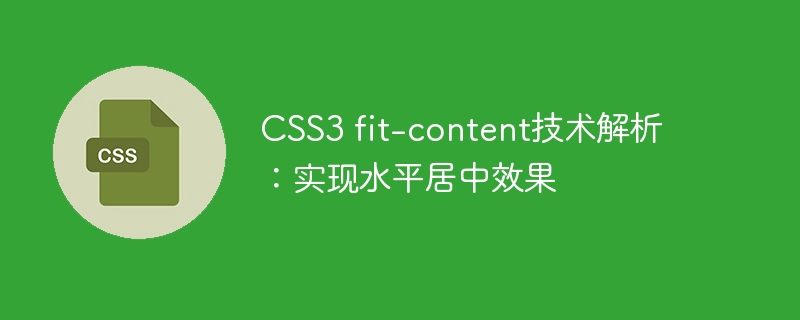Home >Web Front-end >CSS Tutorial >CSS3 fit-content technical analysis: achieving horizontal centering effect
CSS3 fit-content technical analysis: achieving horizontal centering effect
- WBOYWBOYWBOYWBOYWBOYWBOYWBOYWBOYWBOYWBOYWBOYWBOYWBOriginal
- 2023-09-09 15:06:311676browse

CSS3 fit-content technical analysis: achieving horizontal centering effect
Introduction:
In web design, achieving horizontal centering of elements has always been a common and important needs. The previous approach was mostly achieved by setting the margin and padding values of the element, but this method has compatibility issues and is not flexible enough. The fit-content technology introduced in CSS3 provides a simple and reliable way to achieve horizontal centering. This article will provide a detailed analysis of fit-content technology and provide code examples.
What is fit-content:
fit-content is a new value introduced by CSS3, used to set the width or height of an element. It automatically resizes elements based on the actual size of the content without having to manually set specific pixel values.
Use fit-content to achieve horizontal centering:
Using fit-content technology can easily achieve horizontal centering. The following is an example of using fit-content to achieve horizontal centering:
HTML code:
<div class="container">
<div class="content">
内容
</div>
</div>CSS code:
.container {
display: flex;
justify-content: center;
}
.content {
width: fit-content;
}Parsing:
First, in the HTML code , we use a container element (container) that contains content, and nest the content element (content) that needs to be horizontally centered in the container.
In the CSS code, we convert the container element into a flexible container by setting the display property of .container to flex.
Then, we use the justify-content property of .container set to center to center the content element horizontally.
Next, we set the width of .content to fit-content. In this way, when the actual width of the content element is smaller than the container width, the width of .content will automatically adjust to the actual width of the content element, thereby achieving a horizontal centering effect.
Example effect:
Assume that the width of the content element is 200px and the width of the container element is 500px. At this point, the width of .content is automatically adjusted to 200px and centered horizontally in the container. If the width of the content element exceeds the width of the container element, the width of .content is automatically adjusted to the width of the container and the content element overflows.
Compatibility:
CSS3 fit-content technology has relatively good compatibility. This technology is supported by most modern browsers, including Chrome, Firefox, and Safari. However, due to compatibility issues, it is recommended to conduct browser compatibility testing when using this technology and provide alternatives in case browsers that do not support this technology are used.
Summary:
Through fit-content technology, we can easily achieve the horizontal centering effect of elements. It is not only easy to use, but also has good compatibility. We can automatically resize elements based on the actual size of the content, eliminating the need to manually set specific pixel values. I hope the content of this article can help everyone achieve a more flexible and beautiful horizontal centering effect.
Reference:
- CSS fit-content rule: https://developer.mozilla.org/en-US/docs/Web/CSS/fit-content
- Center horizontally using fit-content and flex: https://stackoverflow.com/questions/55249286/center-horizontally-using-fit-content-and-flex
The above is the detailed content of CSS3 fit-content technical analysis: achieving horizontal centering effect. For more information, please follow other related articles on the PHP Chinese website!

